The body shape of an electric guitar is important. It affects the size, weight and comfort when you play it. There is also the visual appeal, which while less important than how it plays, still matters.
So let’s take a look at each of the different electric guitar body shapes and sizes.

I went through quite a few guitars before I found the ones that really suited me. The different necks, the way they sounded etc. all played a role, but so did the shape of the body.
You want a guitar that feels comfortable and sits right. It should be easy to play and not awkward.
But which guitar suits you best will be different to others. We all like different things. Finding a guitar body shape that you feel comfortable playing and you like the look of is essential to enjoying the instrument.
So let’s get into each of the different electric guitar body shapes and sizes and simply show the differences between them as well as looking at if they impact the tone and playability of them.
Electric Guitar Body Shapes
There are 3 types of electric guitar bodies:
- Solid Body
- Semi Hollow Body
- Hollow Body
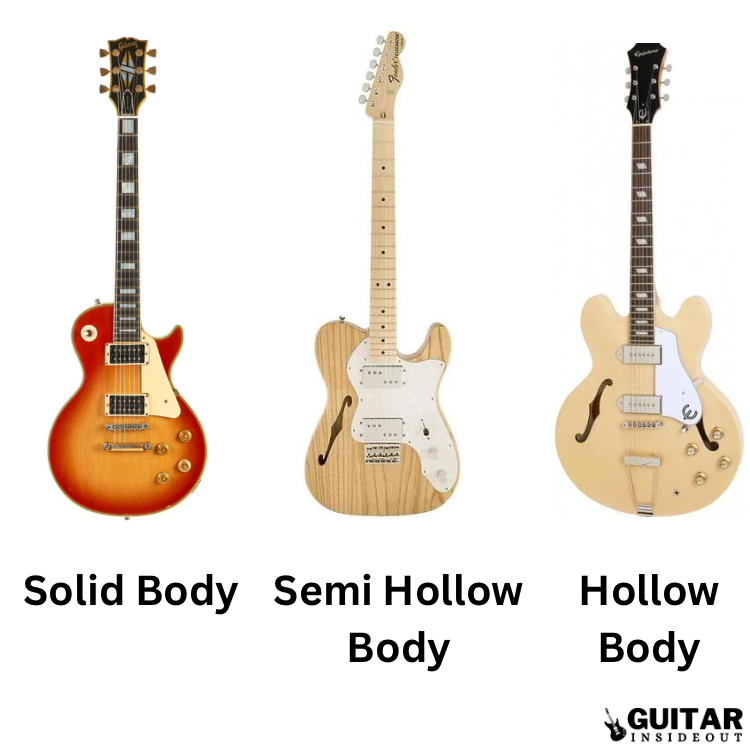
Each of these types of guitar can come in a variety of different body shapes and styles. For example a Fender Stratocaster and Gibson Les Paul are both solid body electric guitars but have very different body shapes and look completely different.
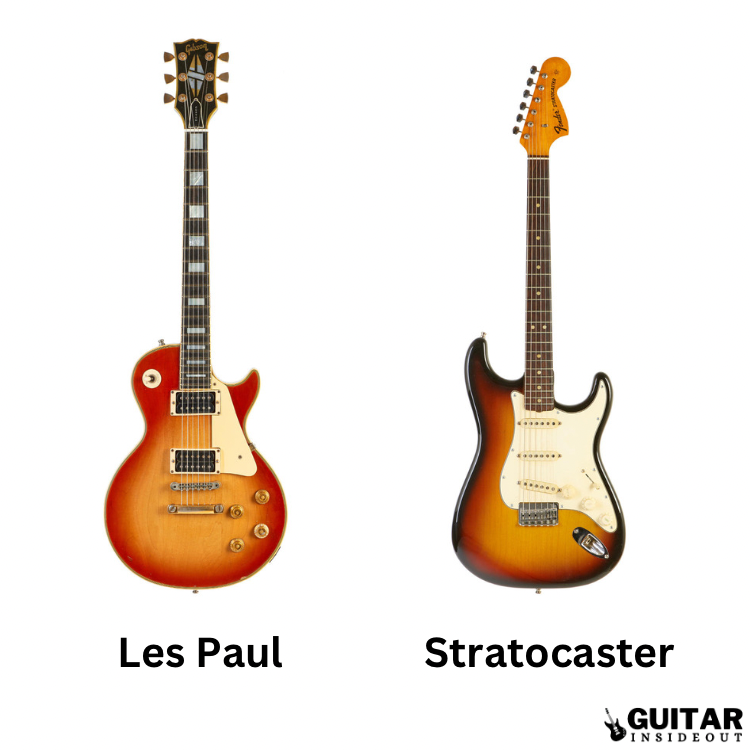
The type of body for each guitar plays a role in how it feels and sounds. Solid body guitars and hollow body guitars will produce very different tones, differ hugely in how much they weigh and be much more suited to certain genres of music.
So let’s look at each type on their own.
Solid Body
A solid body guitar is, as the name implies, made from a solid piece of wood. Unlike the other types of electric guitars – hollow body and semi hollow body – a solid body doesn’t have any chambers and only uses pickups to generate sound.
The design of using a solid body gives the guitar much greater sustain, a more aggressive tone and is less likely to be affected by feedback. This lead to solid body guitars becoming the go-to guitar of choice for most guitarists after they were introduced in the 1950’s.
They’re also the guitar you will see used the most in popular styles of music like pop, rock and metal. They suit modern genres of music better than the other types of guitars due to their sound and flexibility.
There are many different variations of solid body guitars. The original body shapes have become synonymous with the electric guitar and often the brand who first manufactured them.
But they’ve also been copied time and time again which is why you see lots of different guitars by different makes that look very similar. For example a Fender Stratocaster was the first to look the way it does but since then many guitars have been produced that use the Strat style of body but with a slight twist.
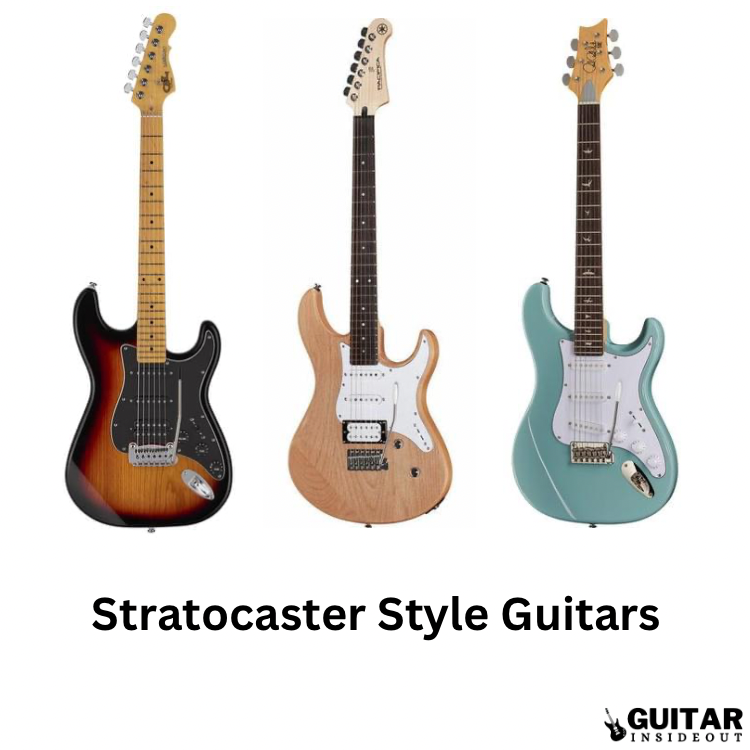
Below we will look at a few of the most well known solid body guitars.
Example Solid Body Electric Guitars
Stratocaster
The Stratocaster is probably the most famous guitar, both electric and acoustic, of all time. It’s design is iconic thanks to being popularized by some of the best and most well known guitarists ever.
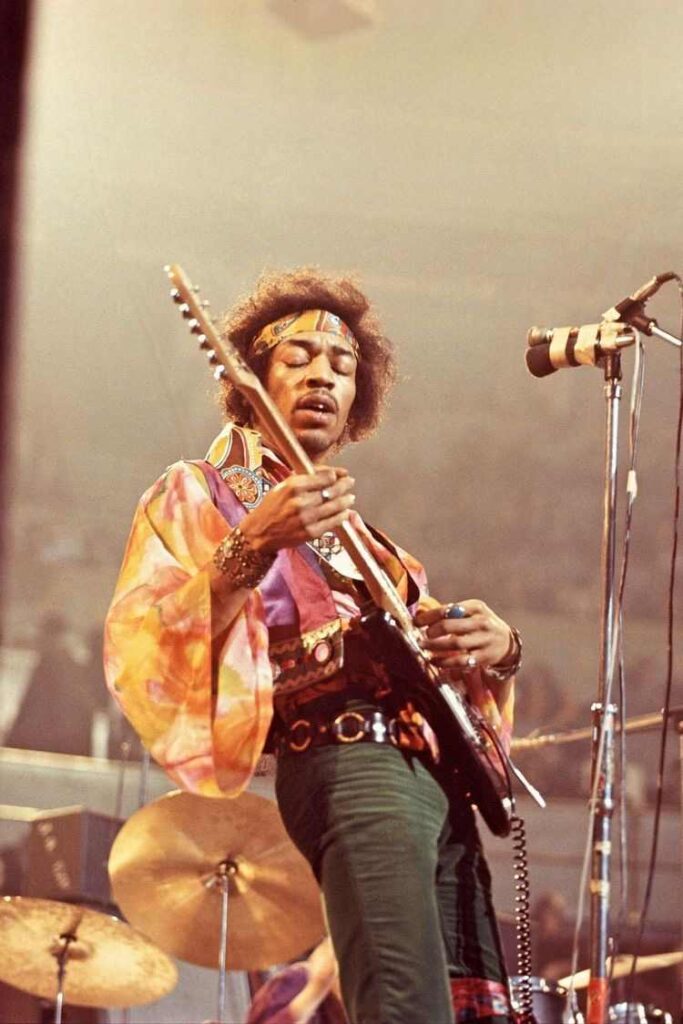
Although it’s as famous as it is it wasn’t actually the first guitar Fender produced (that was the Telecaster which we’ll look at next). It was instantly a success though and since it’s introduction in 1954 it has barely changed.
It features 3 single coil pickups, a 5 way pickup selector switch, a vibrato/whammy bar and the well known Stratocaster body.
The Stratocaster works for most styles of music and you’ll see it used in rock, pop, blues, funk and more. It has a bright tone with excellent clarity and note articulation.
It’s versatility is one of its biggest appeals along with the fact that it just sounds good. That’s why it’s still so popular decades later.

Telecaster
The Telecaster was the first solid body electric guitar that Fender produced, although it was originally called the ‘Esquire’ and only had one pickup. It was was quickly changed to the dual pickup version we know today though and given a new name – ‘Broadcatser’.
Unfortunately Gretsch already had a drum kit and a banjo with a similar name – ‘Broadkaster’, so they sued Fender, who reacted by hastily changing its name to the Telecaster. That was in 1951 and since then the Telecaster has remained a staple of electric guitars and barely changed from its original design.
It was also the first really successful solid body electric guitar. Up until that point hollow body guitars were the only electric guitars being used.
The Telecaster features 2 single coil pickups, a 3 way pickup selector switch and bolt on neck.
Much like a Stratocaster the Telecaster is seen as one of the most versatile guitars out there. You’ll find Telecasters being used in virtually every style of music, from country and pop to rock and blues to punk and alternative. Many guitarists say that it’s their favorite or you don’t need any other guitar than a Tele.
It has a unique sound with more of a twang than a Strat but still that perfect clean tone and vintage sound at the bridge pickup position. The Telecaster neck pickup is also very distinctive and has a warm and bright bell-like sound.
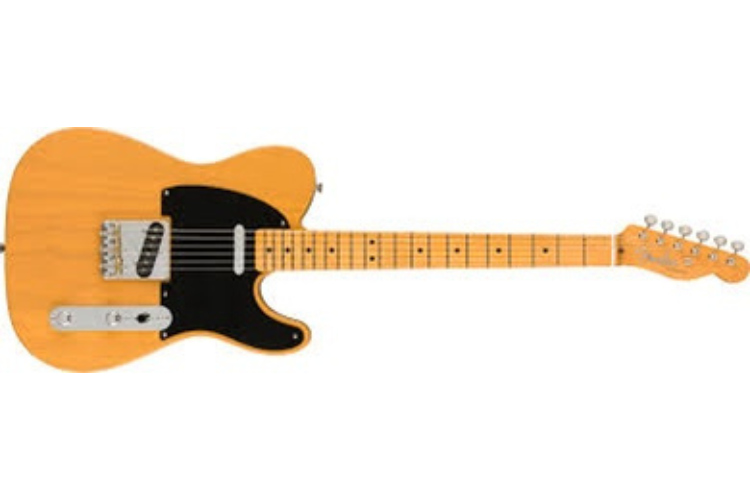
Gibson Les Paul
Gibson’s Standard Les Paul is up there with the Stratocaster as the most famous of all the electric guitars. It was Gibsons first solid body electric guitar but set itself apart from Fender’s Telecaster (and later Stratocaster) with a set neck, a shorter scale length and a single cutaway body.
Originally fitted with 2 single coil pickups instead of the now famous humbucker version the Les Paul found success because those pickups give a thicker sound and greater sustain than its single coil contemporaries. This made it very popular with rock guitarists and although it isn’t consisted quite as versatile as a Strat or Tele it’s has been used across a huge variety of musical genres and styles.
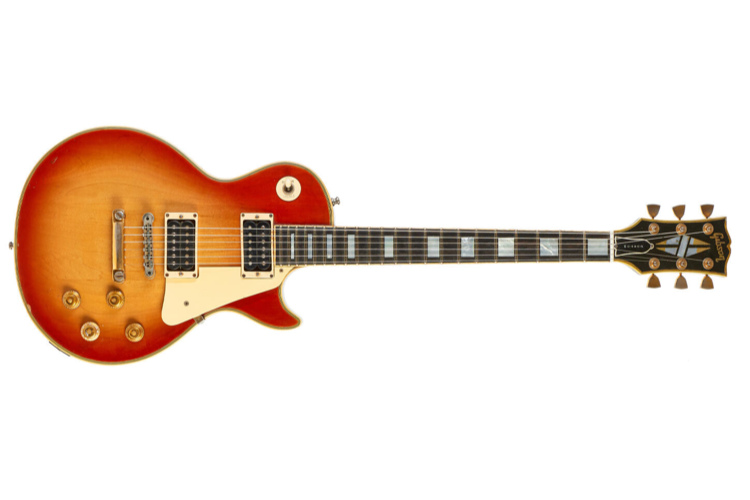
Gibson SG
Maybe not quite as well known as the Les Paul Standard, the SG is still a hugely popular and important electric guitar. It came after the Les Paul, and in fact was another attempt by Gibson to beat the dominant Stratocaster after their sales were struggling.
But it’s very different body style was controversial at the time. It was going to be called the ‘Les Paul SG’ but had been designed without Les Paul’s approval or knowledge.
On seeing it he didn’t like the new design at all and asked for his name to be removed. Despite his reservations the newly named ‘SG’ was a huge success.
With a cheaper price than the Standard Les Paul and it’s distinctive design it has long been very popular. To this day the SG is Gibsons best seller of all time.
The appeal of the SG comes from its light weight, double cutaway body with better access to the upper frets and a very fast neck. These features all made it another very popular option for lead and rock guitarists and those playing faster styles.
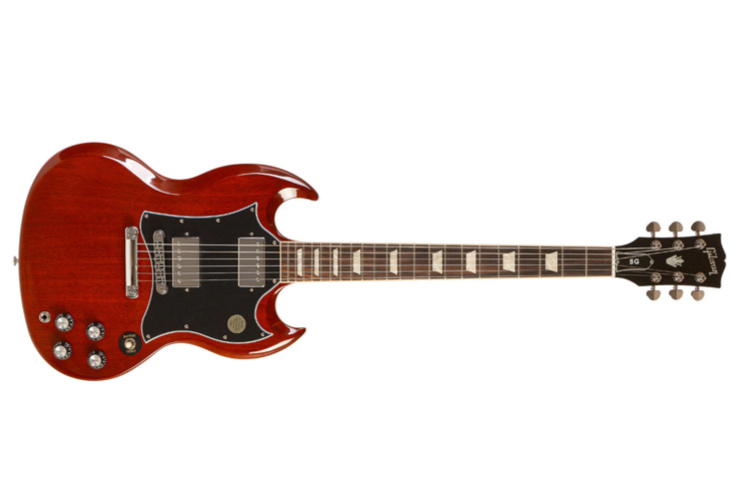
Ibanez RG
The Ibanez RG series of guitars, originally known at the ‘Roadstar’ series, took the Stratocaster body shape and turbocharged it. With a much pointier body style, deeper cutaways for better upper fret access, Floyd Rose bridges and tremolo systems and often a greater number of frets, the result was what has come to be known as a ‘Superstrat’.
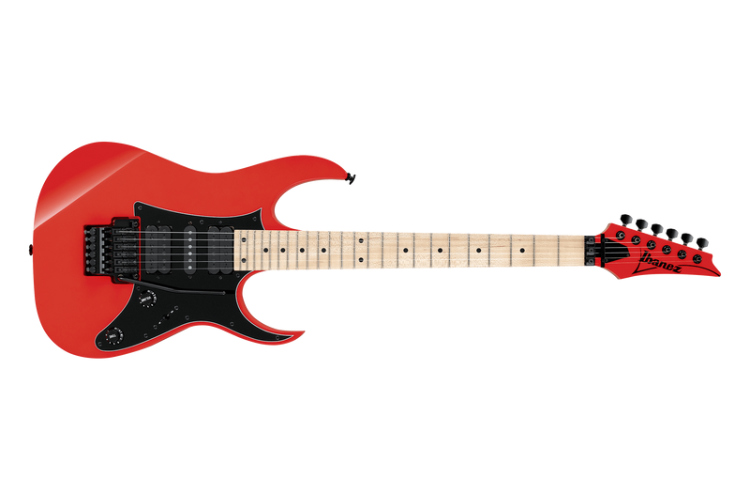
The superstrat became the choice guitar for a lot of rock and metal players in the 80’s and after Ibanez’s and Jackson’s success with the body shape many other guitar manufacturers began copying it. A big part of the appeal was how they looked – regular guitars weren’t showy or flashy enough.
But also the playability was a factor. Standard Stratocasters with single coils were too nosy and thin sounding for the higher gain style and amps of 80’s rock. And both Strats and Les Paul’s could be improved on for comfort and ease of playing the higher frets.
So superstrats, which are essentially modified Stratocasters, were born. They were the perfect mix of comfortable body and fret access, high output pickups and ‘metal’ looking pointed body shapes.
Ibanez and Jackson are probably still the most well known guitar brands associated with superstrats but the likes of Yamaha, Charvel, Dean, Guild and more all did and do make well known superstrat guitars. They aren’t as popular as they were in the 80’s but you still see a lot of them in heavy metal and shred guitarists.
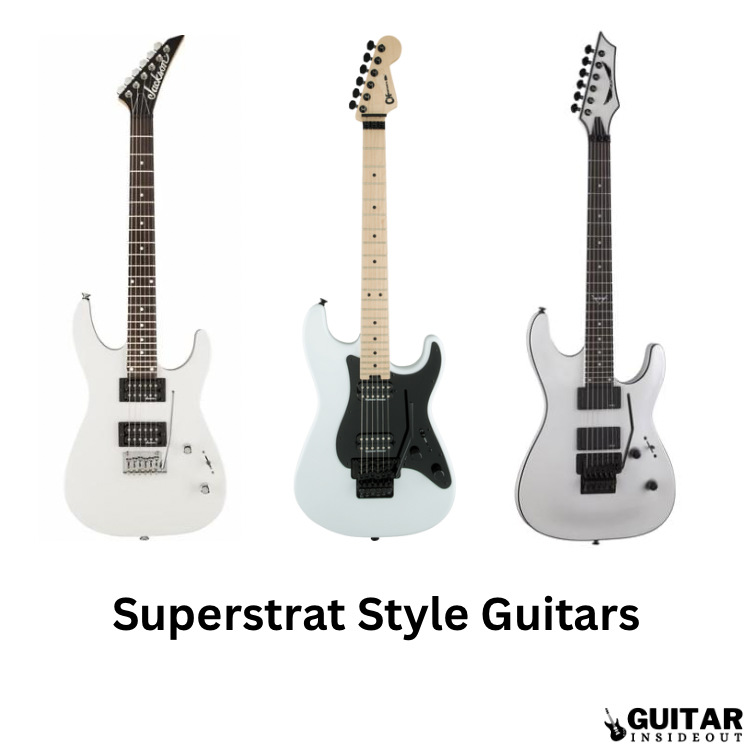
Semi Hollow Body
Semi hollow body guitars actually came after solid body guitars. The first being Gibson’s ES-335, introduced in 1958, which was 6 years after the first solid body.
They have, as their name suggests, a partially hollowed body with “chambers” cut in to the wood and often feature f-holes. Most semi hollow body guitars have a block of wood that runs through the center of the body that the pickups are mounted to.
This makes them lighter and affects the tone.
The idea behind semi hollow guitars is that they would take the positives of hollow body guitars – a more warm and somewhat dark tone and the ability to amplify themselves – and mix that with the positives of solid body guitars – greater sustain and much less feedback.
The outcome would prove to be very popular due to the flexibility in tone semi hollow body guitars produce and how well they work across many different styles of music. This is evidenced by the quick success of Gibson’s ES-335, which became a best seller, and the fact that it’s still in production to this day.
You still find many semi hollow guitars being played today in rock, jazz, blues and more. Dave Grohl (of Nirvana and Foo Fighters) uses a Gibson 335 and even has his own signature DG-335. Eric Clapton used ES-335’s, BB King had his famous ‘Lucille’ ES-355, Chuck Berry a 345 and those are just a few of many.
The semi hollow body guitar may not be as popular as its solid body counterpart but it’s still has an important place in the history of the guitar.
Example Semi Hollow Body Electric Guitars
Gibson ES-335
As mentioned above the Gibson ES-335 was the first semi hollow body guitar. Due to its success it has been imitated (but many would say never bettered) by lots of guitar manufacturers.
It features a set neck, 2 humbucker pickups and a mahogany neck. It’s constructed with a maple block of wood that runs through its center and the body’s upper bouts are hollow with 2 f-holes.
Over the years there have been many different variations on the 335 using it’s semi hollow body design as the basis. The ES-345, 355, Epiphone Dot and more are all based on the original 335. It’s an incredibly important and influential guitar.
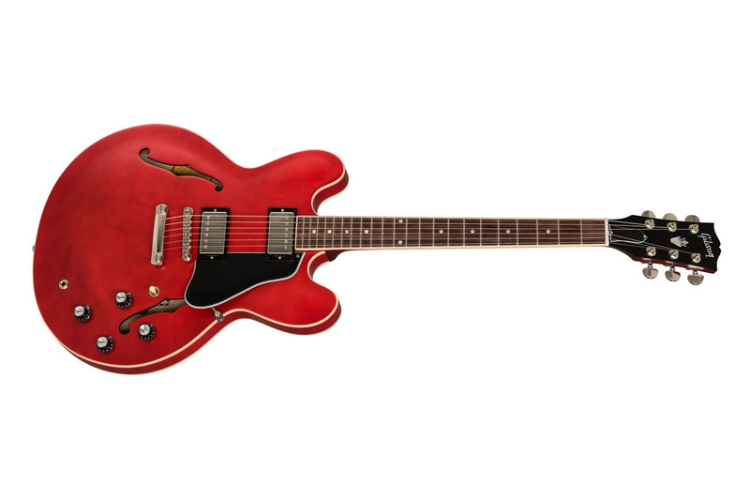
Fender TC90
I couldn’t talk about semi hollow guitars without mentioning my beloved Fender TC90. Not nearly as popular or well known as the likes of Gibsons ES-335, nevertheless it’s a good example of a modern semi hollow body guitar.
Fender have a fair few thinline semi hollow guitars but the TC90 only had a brief run between 2004-2007. 1400 were produced, 700 in two different finishes, and they aimed to create a Les Paul type of sound from a Telecaster style guitar.
And they did a good job! If you find the weight or body shape of a Les Paul a bit too much then the TC90 is a great alternative.
Much lighter, more comfortable and comes surprisingly close to nailing a Les Paul tone. The P90’s and quite dark and can switch between a smooth sound that goes for jazz and blues to much more aggressive that makes it pretty great for punk and alternative music.
You can read my review of the Fender TC90 if you want more information about it.
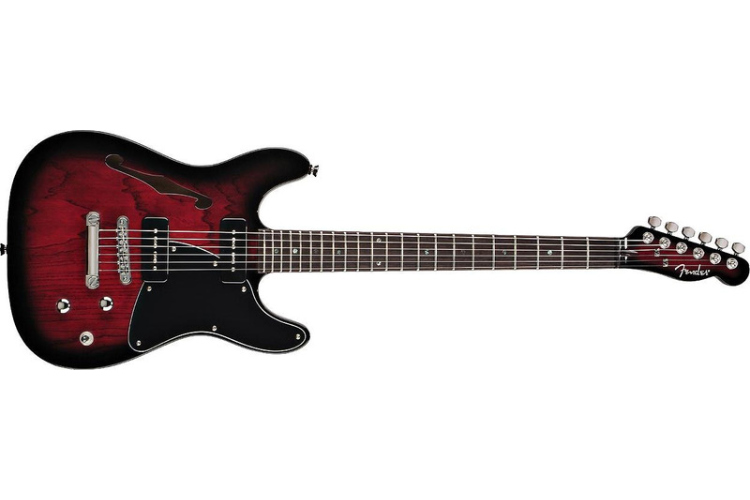
Hollow Body
The original type of electric guitar – the hollow body. When guitar makers wanted to increase the sound a guitar was capable of they looked to amplification.
Amplifying the sound an acoustic guitar made would make it able to keep up with drums and other louder instruments. So guitar manufacturers installed an electric pickup that would amplify the sound of the strings through a speaker.
Rickenbacker’s Electro-A22, fondly nicknamed the ‘Frying Pan’, was the first hollow body electric guitar. The idea was fairly simple: a magnetic pickup was mounted to a regular steel guitar and the electric signal it produced was amplified via a speaker.
Gibson hit on success with the ES-150, their first electric guitar. Although Rickenbacker had the ‘Frying Pan’ before them the popularity of the ES-150 meant it is often seen as the first commercially successful electric guitar.
These guitars had a warm tone and were quickly favored by blues and jazz guitarists. In the 1930’s you would start to see electric hollow body guitars like Gibson’s ES-150 appearing in big bands.
The drawbacks were the amount of feedback they produced when they were played loudly. This meant they weren’t used by bands who were playing larger venues as the feedback would ruin the performance.
Example Hollow Body Electric Guitars
Gibson ES-150
The ES-150 takes its name from ‘Electric Spanish’, as it was the first electrified spanish style guitar, and “150” referring to the price it cost in 1936 when it was first released. Quickly becoming a success and featuring a bar style pickup, it heralded the beginning of electric guitars.
One of the reasons for the ES-150’s success was it’s endorsement from famous guitarists of the time. Jazz and big band players such as Charlie Christian and Eddie Durham began using ES-150’s and this propelled them into the mainstream of music.
They remained popular into the 1940’s, with new models introduced when sales began to drop. These featured new pickups in different positions (nearer to the bridge). But by the late 1950’s the 150 had been surpassed by other models, including solid and semi hollow body guitars, and it was discontinued.
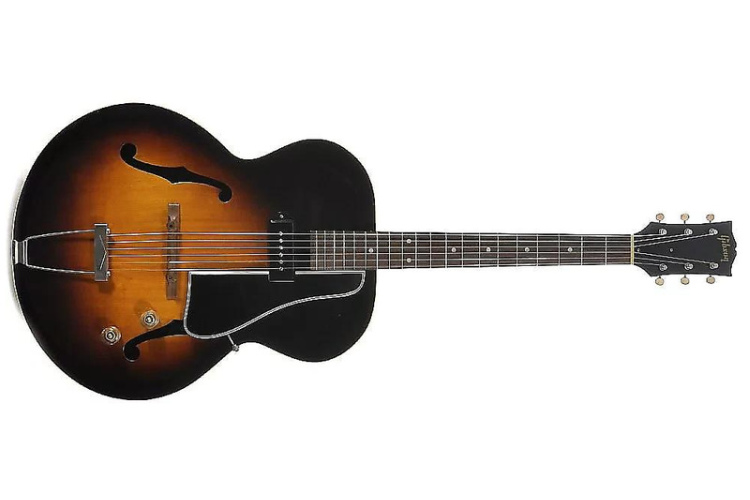
Gibson ES-175
Like the ES-150, the “175” was named after it’s price – $175. But where the 150 gained popularity quickly and then faded away the ES-175 was as an instant hit and remained a staple of Gibson’s lineup for decades, only being discontinued in 2019, giving it a 70 year lifespan (1949 -2019).
A classic example of a hollow body electric guitar, the 175 was quietly revolutionary in that it’s new florentine cutaway replaced the Venetian cutaway that was more popular at the time. It made access to the upper frets far easier than the Venetian cutaway, and combined with the guitars warm tone and ability to amplify the sound it began hugely popular with jazz guitarists.
Originally designed with a single P90 pickup, in 1953 a two P90 pickup version was released and then in 1957 a double humbucker version.
The ES-175 has even remained popular cloth more modern musicians – guitarists like John Frusciante of Red Hot Chili Peppers and Geordie Walker of Killing Joke.
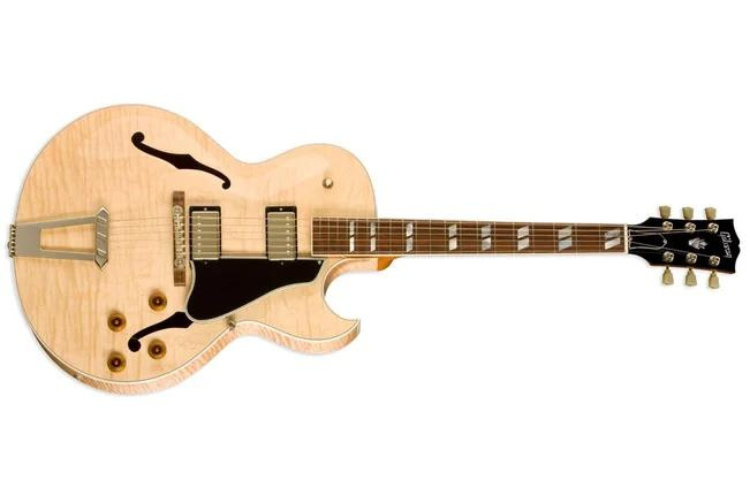
Epiphone Casino
The Casino is arguably the jewel in Epiphone’s crown. While most of Epiphones line of guitars are budget versions of Gibson’s the Casino is a stand-alone that deserves its rich history and reputation.
The Casino is a fully fledged hollow body guitar and features dual P90 pickups as well as a trapeze tail piece (often upgraded to a Bigsby)
Many amazing artists have used Casino’s over the years, including Glenn Frey (of The Eagles), Keith Richards, Josh Homme (Queens of the Stone Age), Peter Green (Fleetwood Mac), and 3 of the 4 Beatles – John Lennon, George Harrison and Paul McCartney.
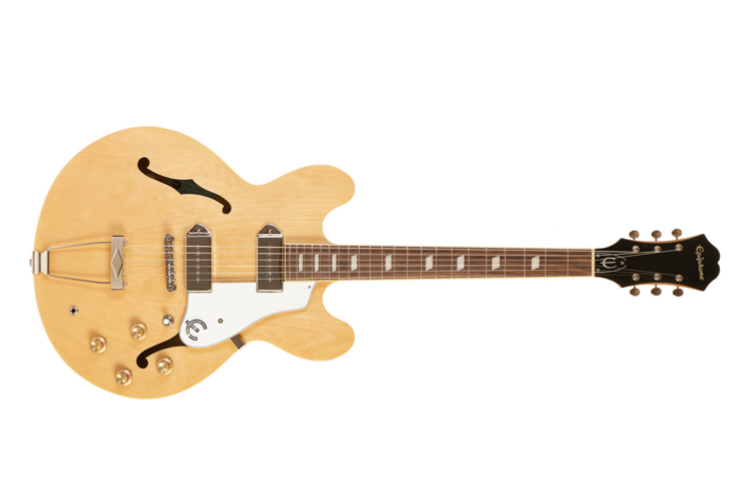
The Differences Between the Types of Guitar Bodies
The main differences between the different types of electric guitar bodies are:
- Solid body electric guitars are made from a single piece of solid wood. They have much greater sustain and clarity than the other types.
- Semi hollow body electric guitars usually have a solid wood block running through the center of the body but with hollow wings or chambers on either side. This design helps to reduce feedback and provide a warmer tone compared to solid body guitars.
- Hollow body electric guitars are completely hollow and don’t have a solid wood block running through their center. They have a distinctive tone that is brighter and full but because of the design they are prone to feedback at high volumes.
- Solid body’s are the most popular type of electric guitar, used in most styles of music although seen predominantly in pop, rock, blues and metal.
- Semi-hollow body and Hollow body guitars are more commonly used in jazz, blues and rockabilly.
- Overall solid body guitars are the most versatile and widely used while semi-hollow and hollow body guitars are often preferred by musicians looking for a specific tone or playing style.
The Evolution of the Electric Guitar Body
The body of the electric guitar has been on quite a journey and evolved through several stages over many decades. As touched upon earlier the electric guitar started out with Rickenbacker’s ‘Frying Pan’ in 1931.
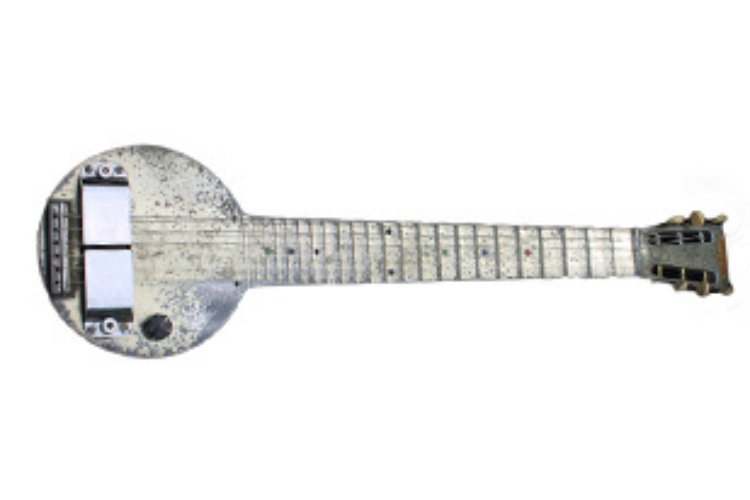
This body type didn’t really catch on though. Looking at it you can sort of see why!
So it wasn’t until Gibson took the idea Rickenbacker had with the Frying Pan and put it into a more traditional looking guitar that the electric really began to take off. Gibson’s early hollow body electric guitars would be the forerunners for the wave of electric guitars that would soon sweep the world of popular music.
The semi hollow body followed, and while it was seen as an improvement it wasn’t radically different from the hollow body. There were important modifications during this time though – cutaways to give better access to the upper frets became standard and would carry on as a major part of a guitars body.
Everything changed in the 1950’s though when Fender released the first solid body electric guitar. The Telecaster and shortly after the Stratocaster revolutionized the guitar world and set the blueprint for electric guitars going forward.
Gibson responded with their Les Paul’s and SG, and since then the electric guitar body has remained pretty similar to this day.
There have been slight alterations and manufacturers have experimented with different body shapes. Gibson went futuristic with the Explorer, Ibanez and Jackson popularized the superstrats, Ernie Ball Music Man have appealed to women with a more friendly body shape in the signature St Vincent, to name just a few.
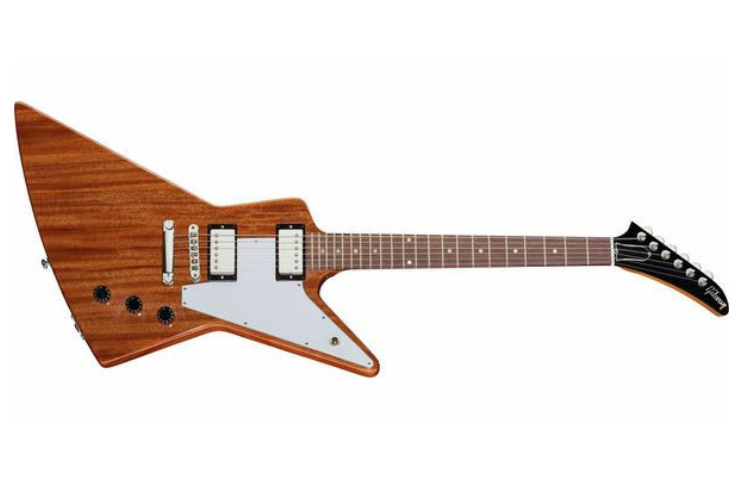
But most electric guitars still keep to the fundamentals that those original Fender’s and Gibson’s established back in the 50’s. The majority of electric guitars are variations on the classics, and while that might be a sign of lacking innovation it seems more like a case of ‘if-it-ain’t-broke-don’t-fix-it’.
Electric Guitar Bodies and Music Genres
It’s important to state that any guitar can be used in and play any genre. Some are more suited to others, absolutely. But that doesn’t mean you can’t play metal with a Strat or country with an Ibanez.
However, if you’ve spent any time watching guitarists of various genres you’ll have noticed that certain types of guitars are used far more frequently in certain genres.
In the world of metal you will see a lot of guitarists using superstrats – Ibanez’s, Jackson’s, Charvel’s etc. They became associated with that genre in the 80’s and it has stuck with those types of guitars ever since.
Straightforward rock and pop have a lot of Strats and Les Paul’s. Jazz guitarists favor semi hollow body’s etc.
In some cases these stereotypes makes sense. Superstrats suit metal and fast, technical styles of playing because of their flat necks, upper fret access, number of frets etc. Les Paul’s are perfect for rock music as their body construction and the single piece of wood combined with the dual humbuckers make for a big, thick tone ideal for rock. And so on.
But it can be a bit limiting to think that you can only play a certain genre of music with a particular type of guitar.
It’s also silly to think that if you play a Jimi Hendrix song using a Stratocaster it’ll sound much more like Jimi himself. Yes, the guitar, pickups and amp played a role in his sound but far more of it was in his fingers.
If I pick up a Strat, Tele or whichever guitar and try and play ‘Little Wing’ it’s never going to sound like Jimi. If he played it on any guitar, from a $50 Chinese copy to a vintage Strat it would sound like him.
So it’s a good idea not to be too concerned with which guitars are associated with which genre. If you like the look and feel of a guitar then that’s all that matters! Play any style you like with it.
How Does An Electric Guitar’s Shape Affect its Sound
It depends somewhat. On an electric guitar the body shape doesn’t really have an affect on the sound. There’s a big divide in options about whether the wood the body is made from and it’s density affects the tone of an electric guitar but the actual shape of a solid body guitar shouldn’t impact the sound.
For hollow body and semi hollow body electric guitars however it’s a different story. The size and shape affect the tone of an acoustic guitar as the soundboard (which is the top of the body) vibrates when the strings and strummed and this amplifies the sound.
As semi hollow and hollow body electric guitars aren’t solid pieces of wood they have similar properties to an acoustic guitar and so their tone is affected in a similar way. Many hollow body guitars are large in size, especially in comparison to electric guitars, and that also contributes to the tone and sound you get from them.
The warmth and ‘full’ sound you find in hollow and semi hollow guitars comes from the acoustic nature of their construction and the number chambers combined with the size of the body.
What is the Most Popular Electric Guitar Body Shape
I don’t think there’s any statistical evidence to back it up but it seems fairly obvious to me that the Stratocaster body shape is the most popular and enduring. You only have to look at the popularity of the Stratocaster itself, the fact that it was the basis for superstrat guitars and the enormous number of Strat copies out there shows that it’s the overwhelmingly most successful body shape.
How Does the Shape of an Electric Guitar’s Body Affect its Playability or Comfort?
Guitars are designed to be try and be comfortable. Many have contours in the body for the arm and belly.
But there’s no denying some feel more comfortable than others. And a lot of the time that’s very much a personal preference.
I find certain guitars really comfortable to play that other people don’t get on with at all, and vice versa. So it comes down to what you like and feels right most of the time.
But there are some aspects of the body shape and it’s playability that isn’t entirely preference.
If you’re quite small then a larger guitar – an Epiphone Casino or Gibson ES-335 for example – is going to be far more awkward to play than a Stratocaster or Telecaster.
Weight also needs to be thought about. Les Paul’s have fairly small body’s but are well known for being one of the heavier electric guitars. The Gibson SG on the other hand is very light.
The other thing to consider is that I’m approaching this as a fairly average sized man. Guitars have, for the most part, been designed entirely with men in mind.
Whether that’s just an oversight or because when guitars were first being made out attitudes towards women and their place in society wasn’t quite where it is today is up for debate. I imagine women guitarists in the 1950’s were probably met with either derision or hostility and not taken seriously.
But either way guitars are going to be more of a struggle for women for one simple reason – biology. Women are different shapes to men so guitars don’t sit the same way against their body.
There are a few guitars that have attempted to right the imbalance. I mentioned the Music Man St Vincent, designed with St Vincent herself (Annie Clark) to be more ergonomically friendly for women. But if you are a woman you probably have to think about the shape of a guitar more than a man.
Before you go…
It’s good to know the different types of guitar amps as well as guitar body’s:
Understanding the Different Types of Guitar Amps (Pros and Cons)
Related Articles